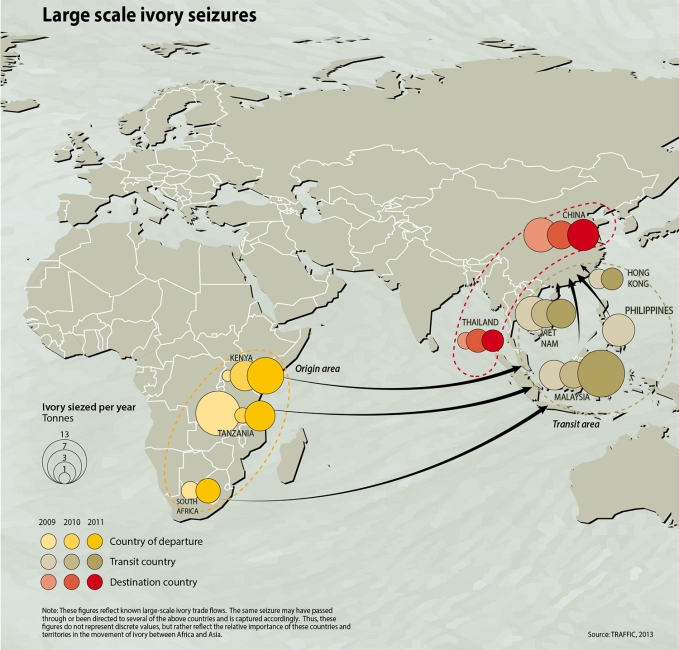Ivory, which is carved into a variation shapes and objects, originates from the tusks of animals found throughout the world. Elephants are the most common source of ivory. Elephants live on the plains of Africa or in the jungles of Asia, and people in these areas were once free to trade ivory to places where it did not originate.
In 1989 CITES banned the international trade of ivory, and member countries of CITES were required to implement their own laws to enforce the ban. However, there was still the issue of ivory that has already been harvested, carved and sold, legally, before the ban was put in place. Countries developed registration systems to identify legal ivory and prevent illegal ivory from entering the legal domestic market. These documentation systems are not always enforced, making it easy for smuggled ivory to be passed off as legal ivory. Once the documents are forged, it is impossible to distinguish between blood ivory and legal domestic ivory.
The lack of regulations on ivory sales in China is driving the underground ivory trade. Sales of ivory for small items such as chopsticks, small trinkets or jewelry do not require documentation. Sellers of larger ivory pieces forge documentation that says the ivory comes from an elephant that died before the CITES ban or that it came from a legal CITES sale. Another tactic that ivory sellers use is to falsely claim that the ivory is mammoth ivory, which does not need documentation because the species is already extinct, yet is impossible to distinguish from elephant ivory.
To learn more about registration problems in China, read the BBC’s article and watch the accompanying video “Uncovering China’s illegal ivory trade” and read Esmond Martin and Lucy Vigne’s report The Ivory Dynasty: A Report on the Soaring Demand for Elephant and Mammoth Ivory in Southern China.
Today illegal poaching of elephants mainly occurs in Central and Eastern Africa. After elephants are slaughtered, tusks travel to major transit hubs such as Mombasa and Dar-es-Salaam. The ports of these African nations have been criticized for lacking the resources for strict enforcement of customs or lacking transparency, making it easy for smugglers to bribe officials or pass without inspection. Ivory is then smuggled onto planes or ships that carry the white gold to numerous Asian trading ports, as well as some in Europe and the United States.
Trafficking routes have become more complex as smugglers send ivory to transit countries to try and avoid getting caught. Authorities are more likely to inspect a shipment for ivory if it was traveling a simple route from Kenya’s largest port in Mombassa to the world’s largest port in Shanghai, China. Instead, smugglers create interact paths for their shipments, first driving ivory to parts of Africa that do not have elephants. From there, the ivory can be flown to different countries in Europe, the Middle East and Asia before it makes its final destination into China. A shipment of luggage coming from Brussels is less likely to be inspected for ivory than a shipment from Kigali.

From: Elephants in the Dust – The African Elephant Crisis, 2013, Author: Riccardo Pravettoni, GRID-Arendal
National Geographic used GPS technology embedded in fake ivory tusks to track the movement of a shipment of ivory. They found that the tusks ended up in areas controlled by armed groups such as the Lord’s Resistance Army and much of the movement within Africa was done by foot.
One of the world’s largest trading ports is in Hong Kong. Smugglers have a high probability of successfully sneaking ivory into Asia through the port because over 6 million containers enter Hong Kong every year and most of them are not fully inspected. Because of its location and high volume of traffic, this port is a critical junction for the transit of ivory. Hong Kong officials have seized more than 33 tonnes of illegally smuggled ivory from their inspections. It is hard to imagine how much illegal ivory passed through in Hong Kong in the goods that were not inspected, hidden in crates of coffee beans or in thick wooden coffins.
Ivory has been seized from other transit and destination countries, such as the United States, China, Australia, France and Germany. Most of the smuggled ivory coming into these countries will make its way onto China’s ivory markets or smaller ivory markets other Asian countries. Smuggled illegal ivory is sold from vendors who disguise the blood ivory as ivory that was poached from an elephant before the CITES ban in 1989, as part of the one-off legal sales from 1997 and 2008, or disguised as mammoth tusk, a species that is already extinct.

